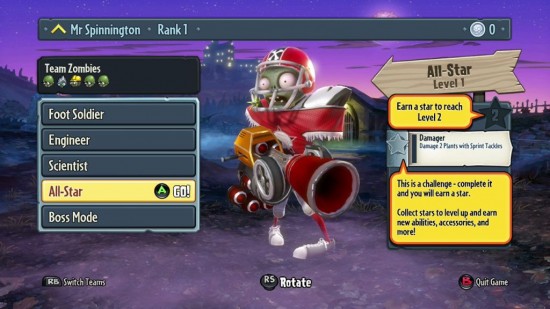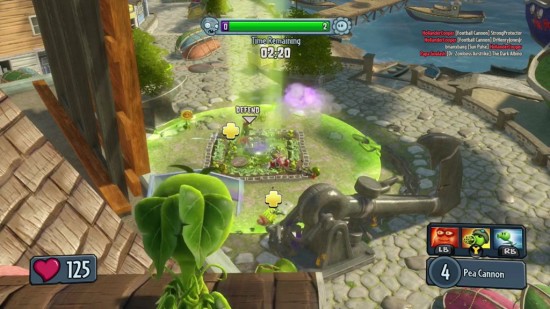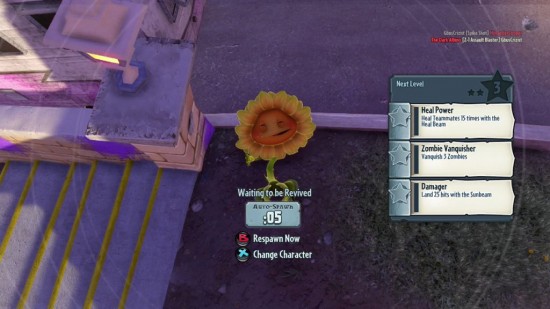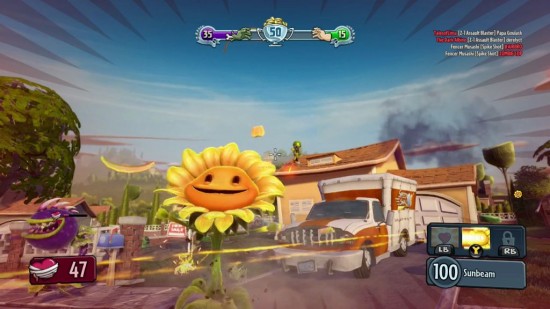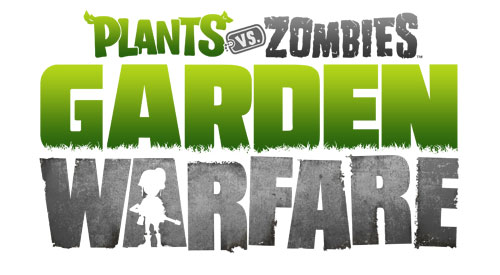 Half of me wants to reach out and touch the 42″ panel in front of me, the other half decides to let common sense take a seat just long enough to return my hand to the grip of an Xbox One controller before submitting to public humiliation. It’s only a few centimeters of progress, but it’s enough for me to privately scold myself– this isn’t an iOS game anymore.
Half of me wants to reach out and touch the 42″ panel in front of me, the other half decides to let common sense take a seat just long enough to return my hand to the grip of an Xbox One controller before submitting to public humiliation. It’s only a few centimeters of progress, but it’s enough for me to privately scold myself– this isn’t an iOS game anymore.
What Plants vs. Zombies: Garden Warfare is, however, is a collection of things you probably like about traditional tower defense games, mixed with the modern twist of controlling a third-person avatar in charge of summoning turrets and firing a lot of their own rounds. While it’s nothing groundbreaking, a small team at EA Vancouver has been drilling down the identifying features of Garden Warfare that ought to help the game speak for itself, even as an Xbox 360/Xbox One timed exclusive.
If I had to choose the most compelling difference between this and games like Santcum or Iron Brigade, it’s going to have to be the buckets of personality that the Plants vs. Zombies name confers. The iOS game was fueled by antics and sight gags, which brings the logical translation into 3D closer to Looney Toons than cutesy 99-cent app drawings. Sure, the designs are clever as you’d expect, but thankfully with utility, such as the rocket launcher on the back of my zombie soldier, or the pea pods reflecting handguns in a Peashooter’s arms. This may also not be a bad time to mention that if you’re a PvZ fan, then you can practically overdose on the callbacks in Garden Warfare now re-purposed for runnin’ and gunnin’.
This must be why an afternoon of playtime has left me tempted with the notion of continuing to compare it to other third-person tower defense shooters. Whether or not that’s a good or bad thing is up to you, but it’s hard to feel like a developer is making a “me too” game when they started out in tower defense in the first place. A brief chat with executive producer Brian Lindley revealed a little more about the game’s development, from the keen interest of a few PopCap employees intent to make a 3D shooter, EA’s support, and the eventual marriage of those ideas to a pre-existing franchise. In under two years, the dozen or so team members have tripled, and the fruit of their labor is a multiplayer game that appears to be hopeful for bridging the gap between the Battlefield crowd and the folks stuck on their smartphones with games like… well, let’s be honest– Plants vs. Zombies.
According to Lindley, Inspiration was taken from games like Star Wars: Battlefront, with the goal to make a “Plants vs. Zombies + Team Fortress 2” shooter– all of which are big words to throw around. Some of them even sound nice, and are especially targeted at a variety of different audiences, should they ever find themselves reading these sentences. What becomes apparent, if anything, is that a wide berth of references can lead to something that stretches itself thin, or maybe doesn’t dare to break a few molds. Likewise, it’s hard to criticize a game for playing it safe as there’s not a precedent to take offense at a developer giving people something they know they like, housing a neutral place of contentment.
After all this belly-aching, it may seem like I didn’t spend an afternoon with Garden Warfare. Maybe that’s due to my initial impressions being that it’s simply competent, albeit a bit typical, and in no short supply of a few good laughs. Some interesting ideas bubble to the surface, such as a generous respawn timer of about 15 seconds on average, but with the option to immediately respawn after waiting just a couple. Being revived obviously doesn’t count as a kill in deathmatch rounds, which impatiently respawning players will come to find when a tide of complaints begins to roll in over their “handing kills” over to the opposing side. I like small complications like this in multiplayer games, where a system allows for player fault in small ways that can lead to great mistakes.
There are a good amount of modes, varying from typical deathmatch to co-op against waves of CPU opponents. Noticeably, in modes with difficulty settings, the challenge became almost an ordeal near the end of the levels. Players looking for a tougher game will be relieved to find they’ll frequently die, but the mode description insists that these Garden Ops areas can be played solo– although even on easy I can’t seem to manage completion of any level by my lonesome. I imagine what the game is trying to tell me is that I can go ahead and play alone if I want to, but I’m really not going to like it.
Well the game’s right. Until another opportunity to play with people, it’s wholly unpleasant when playing alone– and tiresome at that. That goes twofold for the fact that there’s no way to be revived on your own but to spend in-game currency.
So far, in the right setting, I’ve found myself enjoying at least the experience of playing a game with other people, and it’s not unwelcome for that game to be PvZ:GW. The Frostbite 3 makes for a sharp-looking game with loads of particle effects and small touches to keep your eyes busy while making a case for the versatility of a game engine, and a refreshing sense of verticality is present in larger maps, which is a soft spot for me in games. Time will tell how the Sticker Shop card packs, special character classes, and general design hold up, but mostly I’m happy to be in the comfort of my own home where judgement isn’t passed on those who can’t divorce themselves from a history of reaching out to touch plants on a screen.
Stay tuned to see how all of this turned out in our review sometime whenever.


